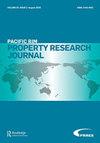Energy efficiency: behavioural effects of occupants and the role of refurbishment for European office buildings
IF 0.3
Q3 Economics, Econometrics and Finance
引用次数: 3
Abstract
Abstract Energy consumption in office buildings is determined partly by fixed building characteristics, but also by the behaviour of occupants. Within the European Union, office buildings have become subject to more stringent energy efficiency regulation for new construction or extensive refurbishment, with the aim to reduce energy consumption and carbon emissions. The study determines the influence of physical building characteristics and occupant behaviour on energy consumption, and in particular, the role of refurbishment in different intensities on energy consumption is investigated. The data-set of the Green Rating Alliance is tested to provide evidence, by applying multiple regression models for energy consumption. The results highlight considerably increased energy consumption of single-tenant compared to multi-tenant office buildings. Very large office buildings consume significantly more energy per square metre that their smaller peers. A building’s modelled water consumption turns out to be a good indicator for the actual energy consumption, emphasising the importance of assessing further sustainability measures. Overall, buildings of higher age turn out to be of lower energy consumption, pointing to additional appliances and equipment in more recent buildings, to provide better services and more comfort. In general, extensive refurbishment measures account for significant higher energy use, since the overall quality of the buildings is improved with additional appliances and equipment. Testing for the interaction effect between building age and refurbishment, the results demonstrate significantly lower additional energy consumption for buildings with more recent extensive refurbishment, compared to those with refurbishment several years ago. However, the results need to be considered with precaution against deriving firm conclusions due to the small sample size and some drawbacks in the applied data-set.能源效率:居住者的行为影响和欧洲办公大楼翻新的作用
办公楼的能源消耗部分取决于建筑物的固定特性,但也取决于居住者的行为。在欧盟内部,为了减少能源消耗和碳排放,新建筑或大规模翻新的办公大楼已经受到更严格的能源效率监管。该研究确定了建筑物理特性和居住者行为对能耗的影响,特别是不同强度的翻新对能耗的作用进行了调查。通过对能源消费的多元回归模型,对绿色评级联盟的数据集进行检验以提供证据。结果显示,与多租户办公大楼相比,单租户办公大楼的能耗显著增加。非常大的办公楼每平方米消耗的能源明显高于较小的同类建筑。建筑物的模拟用水量是实际能源消耗的一个很好的指标,强调了评估进一步可持续性措施的重要性。总体而言,楼龄越高的建筑物能耗越低,这意味着在较新的建筑物中增加了电器和设备,以提供更好的服务和更舒适的环境。一般来说,大规模的翻新措施大大增加了能源的使用,因为建筑物的整体质量因增加了器具和设备而得到改善。对建筑年龄和翻新之间的相互作用效应进行测试,结果表明,与几年前翻新的建筑相比,最近大规模翻新的建筑的额外能耗显著降低。然而,由于样本量小和应用数据集的一些缺点,需要谨慎考虑结果,以免得出确定的结论。
本文章由计算机程序翻译,如有差异,请以英文原文为准。
求助全文
约1分钟内获得全文
求助全文

 求助内容:
求助内容: 应助结果提醒方式:
应助结果提醒方式:


